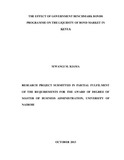| dc.description.abstract | The main objective of this study was to determine the effect of benchmark bonds on the liquidity of bond market in Kenya. In detail, the study sought to establish whether tradefrequency bid-ask spread, tenor structure and volume of issuance influences the liquidity in bond market in Kenya. This study was conducted through analysis of secondary data on Government bonds. The population of this study consisted of government bonds issued between 2001 and 2012. This data is available at the CBK Library and can also be obtained from the NSE or other licensed data vendors such as Reuters or Bloomberg. To identify the effect of benchmark bonds on liquidity of bond market, the study considered yearly average statistics of volumes issued, number of deals, tenors issued and bid-ask spread in absolute numbers. From the findings one can safely conclude that the average volume of issuance per bond and trade frequency have a larger effect on liquidity of bond markets in Kenya. A narrower spread contributes to positive liquidity and likewise, an increasing bid-ask spread would serve to reduce liqudity in bond markets in Kenya. The tenor structure contributes positively to liquidity of bond market by reducing bond fragmentation through large issues of starndardized tenors rather than having small fragments of similar maturities. The study recommends that the CBK should firm up the debt management strategy plan so as to rid the market of small illiquid and high cost bonds. This can be achieved through conducting bond buy backs of the high cost non benchmark bonds. Secondly, there is a need to manage the placement of secondary trade orders so as to avoid possible manipulation of bid-ask spreads by small value orders at wide spreads. Thirdly, the introduction of market makers or primary dealers who would be required to quote firm two-way quotes is inevitable to supplement a liquid bond market. | en |

